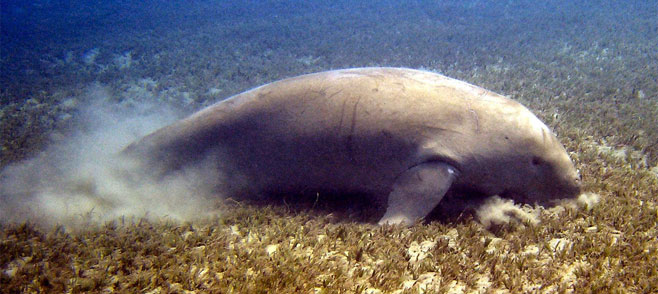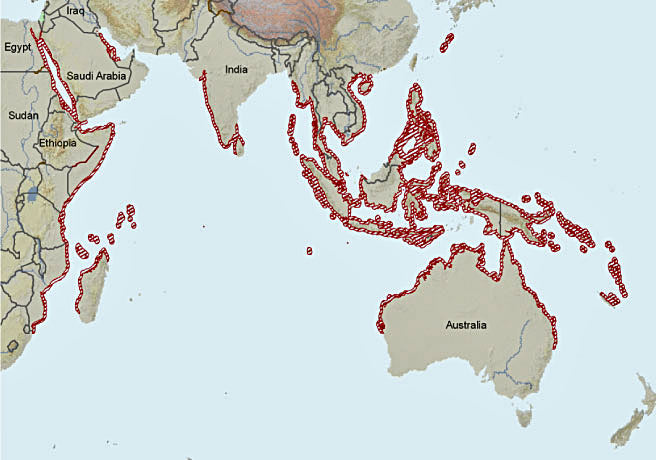|
Dugong dugon
(Dugong, Sea cow, Sea pig)
dugong [Afrikaans]
Life
>
Eukaryotes >
Opisthokonta >
Metazoa (animals) > Bilateria > Deuterostomia >
Chordata > Craniata > Vertebrata (vertebrates) >
Gnathostomata (jawed vertebrates) > Teleostomi (teleost
fish) > Osteichthyes (bony fish) > Class:
Sarcopterygii (lobe-finned fish) > Stegocephalia
(terrestrial vertebrates) > Reptiliomorpha > Amniota >
Synapsida (mammal-like reptiles) > Therapsida > Theriodontia
> Cynodontia > Mammalia (mammals)
> Placentalia (placental mammals) >
Afrotheria > Paenungulata > Tethytheria
 |
|
Dugong in sea grass meadow, Marsa Abu
Dabbab (Red Sea). [photo Mark Goodchild ©] |
Dugongs are entirely aquatic and never come onto land.
Thought to have been mistaken for mermaids by mariners, they have large
cigar-shaped bodies with paddle like foreflippers. The hindlimbs have been lost,
leaving only a vestigial pelvis. The tail has large fleshy tail flukes like
those of a dolphin. They have sparse bristles scattered over their grayish-brown
skin. The large fleshy snout has valved nostrils on the top and is covered with
short, thick bristles. The snout and tusk-like incisors are used to root-up
aquatic plants.
Rarely seen they occur singly, in pairs or small family
groups although occasionally larger family parties of up to 30 animals are
found. They are slow swimmers and expend very little energy.
Unlike most mammals, there is no replacement of milk teeth.
During their lifetime there is a total of six pairs of cheekteeth in both jaws.
Worn teeth are shed at the front and replaced at the back throughout their
lives. This process is repeated until only two pairs of teeth remain in each jaw
in old animals. They share this adaptation where the cheekteeth erupt in a
continuous series with hyraxes and elephants with whom they are thought to have
a common ancestry.
Distribution
 |
|
Distribution of the Dugong [Copyright IUCN 2009.
IUCN Red List of Threatened Species. Version 2009.1.] |
For world distribution, see distribution map above. Within
southern Africa, the Dugong is found along the Mozambique coast and only just
touches into South Africa, on the coast of northern KwaZulu-Natal.
Habitat
Aquatic, shallow sheltered coastal waters in tropical
areas.
Size
Body Length 2.5-4 m; weight range 350 - 900 kg
Gestation
13-14 months
Life span
60 years
Food
Feed predominantly on seagrass growing in shallow
bays and lagoons. Seagrasses are unusual in being
flowering plants that grow in the sea. The favourite seagrasses in the diet
of the Dugong are species of Halodule (Cymodoceaceae)
and Halophila (Hydrocharitaceae)
(Moore 2002). Dugongs are evidently particularly fond of eating Halodule
rhizomes but also eat the leaves.
Halodule uninervis (Narrowleaf seagrass) is the only species of
Halodule occuring in southern Africa and likewise,
Halophila ovalis is the only species of Halophila occuring in the
region.
Dental Formula
I C C P P
Threats
Dugongs are actively hunted by humans as a source of
meat. Their numbers have reduced dramatically in their range and their
conservation status is regarded as vulnerable.
References
-
IUCN 2009. IUCN Red List of Threatened Species. Downloaded report
on Dugong dugon on 21 July 2009. See latest IUCN Redlist status report.
-
Moore, N.W. 2002. Dugong: Status Report and Action Plans
for Countries and Territories (Early Warning and Assessment Report Series).
World Conservation Union
|
